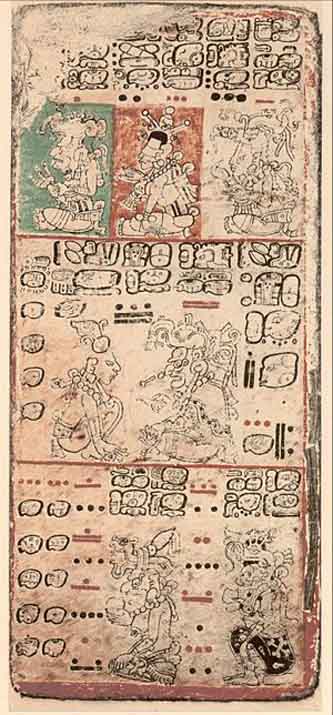
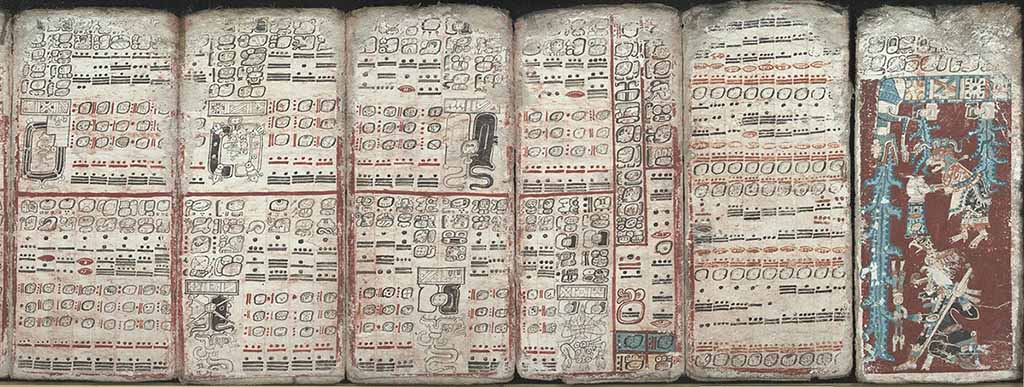
Maya codices (singular codex) are folding books stemming from the pre-Columbian Maya civilization, written in Maya hieroglyphic script on Mesoamerican paper, made from the inner bark of certain trees, the main being the wild fig tree or Amate (Ficus Glabrata), this paper was named by the Mayas Huun, and contained many Glyph and paintings. They are the products of professional scribes working under the patronage of the Howler Monkey Gods. The Maya developed their huun around the V century AD, in the same era that the Romans did, but their paper was more durable and a better writing surface than the papyrus. The codices have been named for the cities in which they eventually settled. The Dresden codex is generally considered the most important of the few that survive.
Such codices were the primary written records of Maya civilization, together with the many inscriptions on stone monuments and stelae that survived. However, their range of subject matter in all likelihood embraced more topics than those recorded in stone and buildings, and was more like what is found on painted ceramics (the so-called 'ceramic codex'). Alonso de Zorita wrote that in 1540 he saw numerous such books in the Guatemalan highlands that "recorded their history for more than eight hundred years back, and that were interpreted for me by very ancient Indians" (Zorita 1963, 271-2).
However, not all were unaware of the books' value; Fr. Bartolome de las Casas lamented that when found, such books were destroyed: "These books were seen by our clergy, and even I saw part of those that were burned by the monks, apparently because they thought they might harm the Indians in matters concerning religion, since at that time they were at the beginning of their conversion." The last codices destroyed were those of Nojpeten, Guatemala in 1697, the last city conquered in the Americas. With their destruction, access to the history of the Maya and opportunity for insight into some key areas of Maya life was greatly diminished. There are only three codices whose authenticity is beyond doubt.


The Dresden Codex, also known as the Codex Dresdensis, is a pre-Columbian Maya book of the eleventh or twelfth century of the Yucatecan Maya in Chichen Itza. This Maya codex is believed to be a copy of an original text of some three or four hundred years earlier. It is the oldest book written in the Americas known to historians. Of the hundreds of books that were used in Mesoamerica before the Spanish conquest, it is one of only 15 that have survived to the present day.
The Dresden Codex consists of 39 sheets, inscribed on both sides, with an overall length of 3.56 metres (11.7 feet). Originally, the manuscript had been folded in accordion folds. Today, it is exhibited in two parts, each of them approximately 1.8 metres (5.9 feet) long, at the museum of the Saxon State Library in Dresden, Germany. The document has played a key role in the decipherment of Mayan hieroglyphs.
Johann Christian Gotze, Director of the Royal Library at Dresden, purchased the codex from a private owner in Vienna in 1739. It was described, at the time of acquisition, as a "Mexican book." How it came to Vienna is unknown. It is speculated that it was sent by Hernan Cortes as a tribute to King Charles I of Spain in 1519. Charles had appointed Cortes Governor and Captain General of the newly conquered Mexican territory. The codex has been in Europe ever since.
In 1810, Alexander von Humboldt published five pages from the Dresden Codex in his atlas Vues des Cordilleres et Monuments des Peuples Indigenes de l'Amerique. The state library of Saxony, the Royal Library in Dresden, first published the codex in 1848. It was not until 1853 that Charles Etienne Brasseur de Bourbourg identified the Dresden Codex as a Mayan manuscript.
In 1835, the codex was placed between glass panes in two parts measuring 1.85 metres (6.1 feet) and 1.77 metres (5.8 feet) in length. Between 1880 and 1900, Dresden librarian Ernst Wilhelm Forstemann succeeded in deciphering the calendar section including the Maya numerals used in the codex.
These numbers are based on a vigesimal (base-20) numeral system, made up of three symbols: zero (shell shape), one (a dot) and five (a bar). Important milestones in the subsequent decoding of the non-calendar section were the assignment of gods to specific glyphs by Paul Schellhas in 1897 and Yuri Knorozov's phonetic approach to deciphering in the 1950s. Knorozov's work was based on the De Landa alphabet, developed by Diego de Landa around 1566.
The library that held the codex was bombed and suffered serious damage during the firebombing of Dresden in World War II. The Dresden Codex was heavily water damaged. The codex was meticulously restored; however, some of the pages were returned to the protective glass cabinet out of sequence. They have remained this way because the water damage caused some of the painted areas to adhere to the glass.
The Dresden Codex is considered the most complete of the three indisputably authentic Maya codices. The names of the codices indicate where they are housed. The Dresden Codex is made from Amatl paper ("kopo", fig-bark that has been flattened and covered with a lime paste), doubled in folds in an accordion-like form (sometimes called leporello) of folding-screen texts. The codex of bark paper is coated with fine stucco or gesso and is eight inches high by eleven feet long.
The Dresden Codex totals 78 pages on 39 double-sided sheets, with an overall length of 3.56 metres (11.7 feet). Four pages are empty. Each sheet measures 20.5 centimetres (8.1 in) by 10.0 centimetres (3.9 in). Originally, the codex had been accordion-folded.
Since 1835 it has been exhibited in two parts, each of them preserved between glass panes. The first part contains 20 sheets, the second 19. The codex was written by six different scribes using both sides. They all had their own particular writing style, glyphs and subject matter. The images of the codex were painted with extraordinary clarity using very fine brushes. The basic colors used for the codex, made of vegetable dyes, were red, black and the so-called Mayan blue.
Around 250 of the approximately 350 signs of the Dresden Codex have been decoded. Most of them refer to the accompanying figures. They comment on the images in short phrases. There are also numbers, consisting of bars (meaning "five"), dots (meaning "one") and stylized shells (meaning "zero").
The Dresden Codex contains astronomical tables of great accuracy. It is most famous for its Lunar Series and Venus table. The lunar series has intervals correlating with eclipses. The Venus Table correlates with the apparent movements of the planet. The codex also contains almanacs, astronomical and astrological tables, and ritual schedules. The specific numen references have to do with a 260-day ritual cycle divided up in several ways. The Dresden Codex also includes instructions concerning new-year ceremonies as well as descriptions of the Rain God's locations.
Today's page numbers were assigned to the codex by Agostino Aglio when he became the first to transcribe the manuscript in 1825/26. For this, he divided the original codex into two parts, labeled Codex A and Codex B. He sequenced Codex A on the front side followed by its back side, with the same order on Codex B. Today, we understand that a codex reading should traverse the complete front side followed by the complete back side of the manuscript, i.e., pages 1–24 followed by 46-74, followed by 25-45.
The librarian K. C. Falkenstein adjusted the relative position of pages for "esthetical reasons" in 1836, resulting in today's two similar length parts. While deciphering the codex, the librarian E. W. Forstemann noticed an error in Aglio's page assignment of the sheets 1/45 and 2/44, so he correctly reassigned Aglio's pages 44 and 45 to become pages 1 and 2. The reversal of the sheets 6/40, 7/39 and 8/38 is due to an error when the sheets were returned to their protective glass cabinet after drying from the water damage due to the bombing of Dresden in 1945.
This ancient text reveals a Maya astronomer calculated the movements of Venus over a millennium ago Science Alert - August 18, 2016
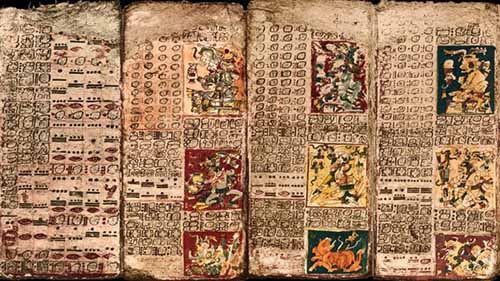
A new analysis of the ancient Mayan text, the Dresden Codex - the oldest book written in the Americas known to historians - suggests an early Maya scientist may have made a major discovery in astronomy more than a thousand years ago. According to a new study, astronomical data written in part of the text called the Venus Table weren't just based on numerology as had been thought, but were a pioneering form of scientific record-keeping that had huge significance for Maya society. A "mathematical subtlety", which scholars have long known about but considered a numerological oddity, serves as a correction for Venus's irregular cycle, which lasts 583.92 days, just like our own Gregorian calendar incorporates leap years.
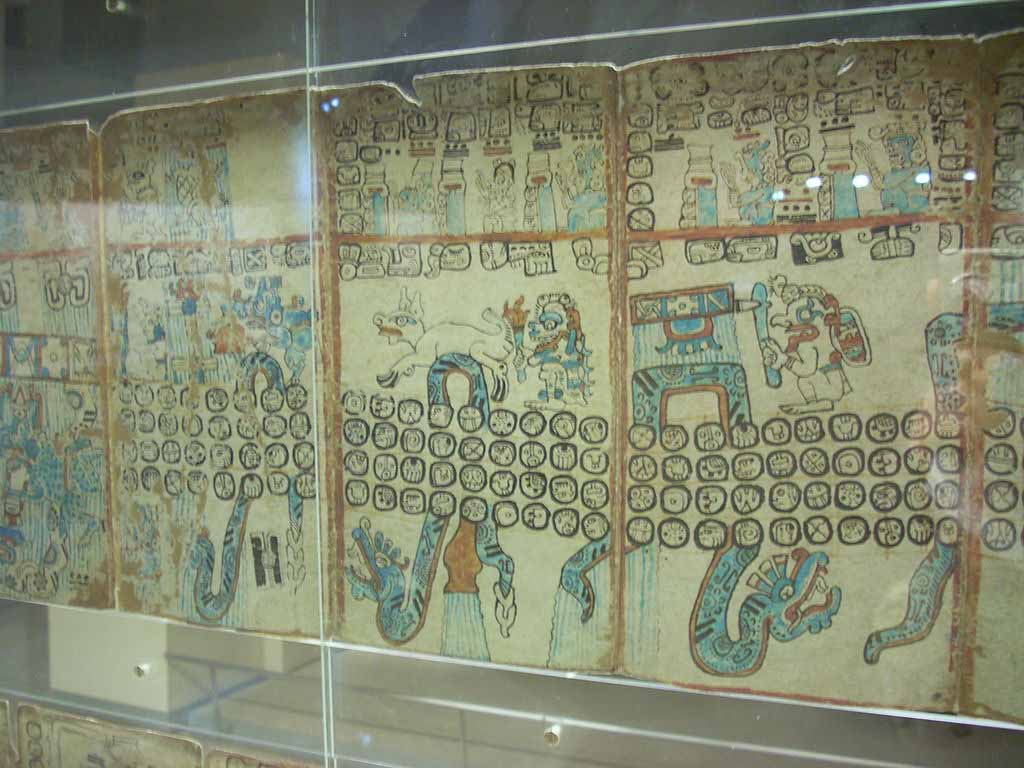
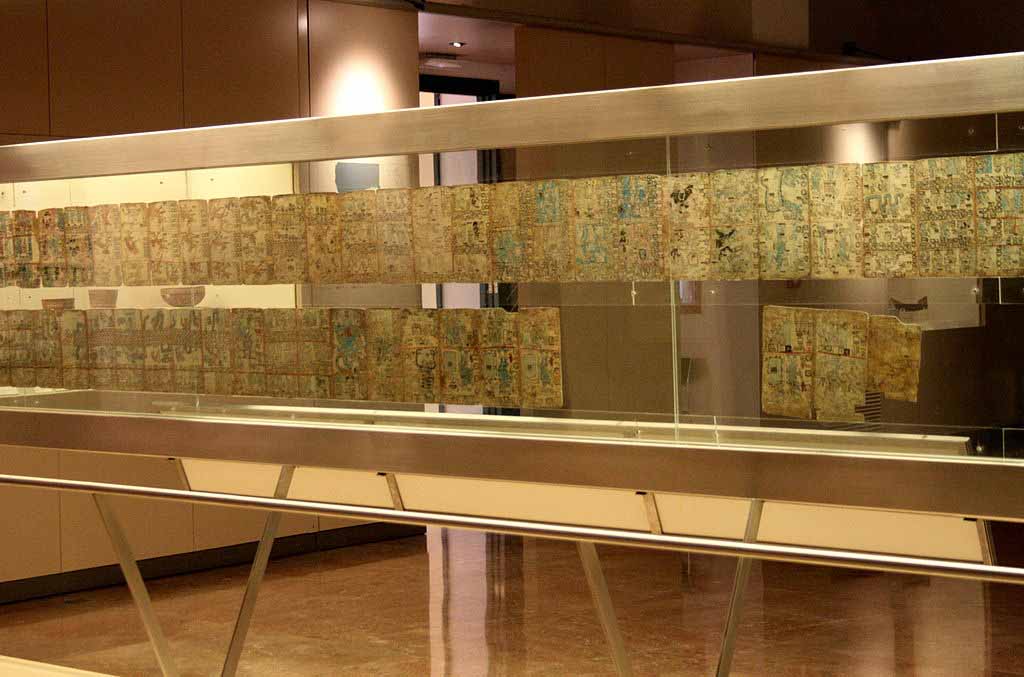
The Madrid Codex (also known as the Tro-Cortesianus Codex or the Troano Codex) is one of three surviving pre-Columbian Maya books dating to the Postclassic period of Mesoamerican chronology (circa 900-1521 AD). The Madrid Codex is held by the Museo de America in Madrid and is considered to be the most important piece in its collection. However, the original is not on display due to its fragility; a faithful copy is displayed in its stead.
The Codex was made from a long strip of amate paper that was folded up accordion-style. This paper was then coated with a thin layer of fine stucco, which was used as the painting surface. The complete document consists of 56 sheets painted on both sides to produce a total of 112 pages. The Troano is the larger part, consisting of 70 pages comprising pages 22–56 and 78–112. It takes its name from Juan Tro y Ortolano, its original owner. The remaining 42 pages were originally known as the Cortesianus Codex, and include pages 1-21 and 57-77. Each page measures roughly 23.2 by 12.2 centimetres (9.1 by 4.8 in).
The Madrid Codex is the longest of the surviving Maya codices. Its content mainly consists of almanacs and horoscopes used to help Maya priests in the performance of their ceremonies and divinatory rituals. The codex also contains astronomical tables, although fewer than are found in the other two surviving Maya codices. Some of the content is likely to have been copied from older Maya books. Included in the codex is a description of the New Year ceremony.
The codex is stylistically uniform, leading Coe and Kerr to suggest that it was the work of a single scribe. Closer analysis of glyphic elements suggests that a number of scribes were involved in its production, perhaps as many as eight or nine, who produced consecutive sections of the manuscript. The religious content of the codex makes it likely that the scribes themselves were members of the priesthood. The codex probably was passed down from priest to priest and each priest who received the book added a section in his own hand.
The images in the Madrid Codex depict rituals such as human sacrifice and invoking rainfall, as well as everyday activities such as beekeeping, hunting, warfare, and weaving.
Some scholars, such as Michael Coe and Justin Kerr, have suggested that the Madrid Codex dates to after the Spanish conquest, but the evidence overwhelmingly favours a preconquest date for the document. The codex likely was produced in Yucatan. The language used in the document is Yucatecan, a group of Mayan languages that includes Yucatec, Itza, Lacandon, and Mopan; these languages are distributed across the Yucatan Peninsula, including lowland Chiapas, Belize, and the Guatemalan department of Peten. J. Eric Thompson was of the opinion that the Madrid Codex came from western Yucatan and dated to between 1250 and 1450 AD. Other scholars have expressed a differing opinion, noting that the codex is similar in style to murals found at Chichen Itza, Mayapan, and sites on the east coast such as Santa Rita, Tancah, and Tulum. Two paper fragments incorporated into the front and last pages of the codex contain Spanish writing, which led Thompson to suggest that a Spanish priest acquired the document at Tayasal in Peten.
The codex was discovered in Spain in the 1860s; it was divided into two parts of differing sizes that were found in different locations. The codex receives its alternate name of the Tro-Cortesianus Codex after the two parts that were separately discovered. Early Mayanist scholar Leon de Rosny realized that both fragments were part of the same book. The larger fragment, the Troano Codex, was published with an erroneous translation in 1869–1870 by French scholar Charles Etienne Brasseur de Bourbourg, who found it in the possession of Juan de Tro y Ortolano in Madrid in 1866 and first identified it as a Maya book. Ownership of the Troano Codex passed to the Museo Arqueologico Nacional ("National Archaeological Museum") in 1888.
Madrid resident Juan de Palacios tried to sell the smaller fragment, the Cortesianus Codex, in 1867. The Museo Arqueológico Nacional acquired the Cortesianus Codex from book-collector Jose Ignacio Miro in 1872. Miro claimed to have recently purchased the codex in Extremadura. Extremadura is the province from which Francisco de Montejo and many of his conquistadors came, as did Hernan Cortes, the conqueror of Mexico. One of these conquistadors possibly brought the codex to Spain; the director of the Museo Arqueologico Nacional named the Cortesianus Codex after Hernan Cortes, supposing that he himself had brought the codex to Spain.
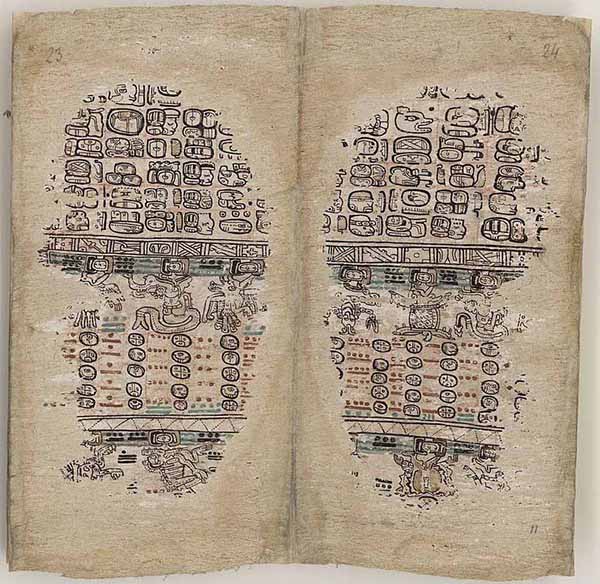
The Paris Codex (also known as the Codex Peresianus and Codex Perez) is one of three surviving generally accepted pre-Columbian Maya books dating to the Postclassic Period of Mesoamerican chronology (c. 900-1521 AD). The document is very poorly preserved and has suffered considerable damage to the page edges, resulting in the loss of some of the text. The codex largely relates to a cycle of thirteen 20-year k'atuns and includes details of Maya astronomical signs.
The Paris Codex is generally considered to have been painted in western Yucatan, probably at Mayapan. It has been tentatively dated to around 1450, in the Late Postclassic period (AD 1200-1525). More recently an earlier date of 1185 has been suggested, placing the document in the Early Postclassic (AD 900-1200). However, the astronomical and calendrical information within the codex are consistent with a Classic period cycle from AD 731 to 987 indicating that the codex may be a copy of a much earlier document. The Paris Codex is currently held at the Bibliotheque Nationale de France in Paris, in the Departement des Manuscrits, catalogued as Mexicain 386.
The codex is formed from a strip measuring 140 centimetres (55 in) long by 23.5 centimetres (9.3 in) high, folded into 11 sheets painted on both sides. It is very poorly preserved, comprising a number of fragments; the lime plaster coating of the codex is badly eroded at the edges, resulting in the destruction of its hieroglyphs and images except in the centre of its pages.
The content of the codex is mainly ritual in nature, and one side of the codex contains the patron deities and associated rituals for a cycle of thirteen k'atuns (a 20-year Maya calendrical cycle). One fragment contains animals that represent astronomical signs along the ecliptic including a scorpion and a peccary; fragments of this Maya "zodiac" are depicted on two pages of the codex. Some pages of the codex are marked with annotations made with Latin characters.
On one side of the codex the general format of each page largely follows the same arrangement, with a standing figure on the left hand side and a seated figure on the right hand side. Each page also contains the ajaw day glyph combined with a numerical coefficient, in each case representing a date marking the final day of a calendrical cycle. In spite of the poor state of preservation of the document, enough text has survived to demonstrate that in the case of the Paris Codex, the main series of dates correspond to k'atun-endings, allowing for the reconstruction of some of the lost date glyphs in the text. The seated figures are each associated with a sidereal glyph indicating that they represent the ruling deity of each k'atun.
The reverse of the codex is more varied in nature and includes a section dedicated to a calendrical cycle ruled by Chaac, the god of rain. A set of two pages illustrates the days of the tzolk'in 260-day cycle that correspond to the beginning of the solar year over a period of 52 years (a cycle of the Calendar Round). The final two pages of the codex depict a series of thirteen animals that represent the so-called "zodiac".
In common with the other two generally accepted Maya codices (the Dresden Codex and the Madrid Codex), the document is likely to have been created in Yucatan. Analysis of the stela in suggests a date of 1185 indicating that the calendrical information may refer to an earlier k'atun cycle than the one suggested by Love. The astronomical and calendrical information within the Paris Codex are consistent with a Classic period cycle from AD 731 to 987 indicating that the codex may be a copy of a much earlier document. Discovery.
The Paris Codex came to light in 1859 when Leon de Rosny found it in a basket of old papers in the corner of a chimney in the Bibliotheque Imperiale in Paris. The codex had apparently been examined some twenty-five years earlier by scholars and had been catalogued but it is not known how the document found its way to Paris. The document was found with a piece of paper attributing it to the collection of colonial Maya documents assembled by Juan Pío P'rez.
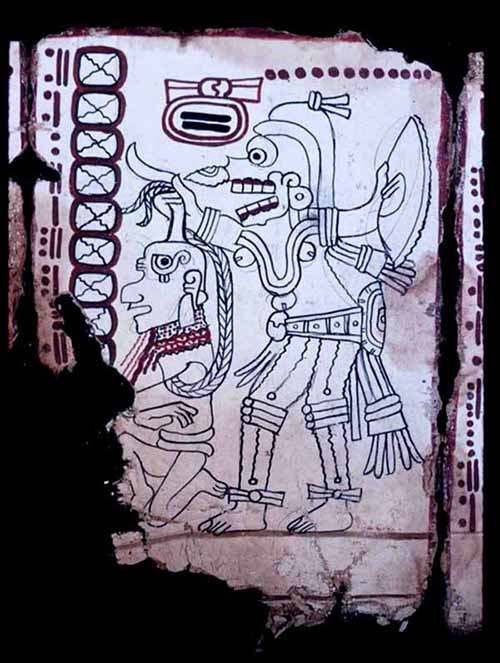
.
The Grolier Codex (sometimes referred to as the Saenz Codex) is a Maya book of a pre-Columbian type but of disputed authenticity. It first appeared in a private collection in the 20th century and was displayed at the Grolier Club in New York, hence its name.
The codex consists of a fragment of a Maya book, containing almanacs of Venus represented in a simplistic fashion. The Grolier Codex would be only the fourth surviving pre-Columbian Maya book if genuine. The codex is said to have been recovered from a cave in the Mexican state of Chiapas in the 1960s, together with a mosaic mask and some blank pages of pre-Columbian fig-bark paper.
It was displayed at the Grolier Club from April 20 to June 5, 1971, and is now held in Mexico City. In 1973, Michael D. Coe published the first half-size recto-side facsimile of the codex in The Maya Scribe and His World, produced by the Grolier Club. The codex contains a Venus almanac that, in structure, is closely related to the Venus almanac contained in the Dresden Codex.
The codex, although displaying Mixtec stylistic features, is judged to be Maya (if genuine) based upon the use of bark paper instead of the deerhide preferred for Mixtec codices and because of the presence of Maya day signs and numbering.
The codex is poorly preserved; the surviving page fragments display a number of figures in central Mexican style, combined with Maya numbering and day glyphs. The document is currently held by the Museo Nacional de Antropología in Mexico city and is not on public display. The physics institute of the Universidad Nacional Autonoma de Mexico subjected the codex to non-destructive testing in an effort to determine its authenticity. The results were published in 2007 and were mixed; the document apparently contains genuine pre-Columbian materials but certain aspects, such as seemingly artificially induced wear and tear, are suspect. The researchers concluded that they were unable to prove or disprove the pre-Columbian nature of the codex. ú
Given the rarity and importance of these books, rumors of finding new ones often develop interest. Archaeological excavations of Maya sites have turned up a number of rectangular lumps of plaster and paint flakes, most commonly in elite tombs. These lumps are the remains of codices where all the organic material has rotted away.
A few of the more coherent of these lumps have been preserved, with the slim hope that some technique to be developed by future generations of archaeologists may be able to recover some information from these remains of ancient pages. The oldest Maya codices known have been found by archaeologists as mortuary offerings with burials in excavations in Uaxactun, Guaytan in San Agustín Acasaguastlan, and Nebaj in El Quicha, Guatemala, at Altun Ha in Belize and at Copan in Honduras. The six examples of Maya books discovered in excavations date to the Early Classic (Uaxactun and Altun Ha), Late Classic (Nebaj, Copan), and Early Postclassic (Guaytan) periods. Unfortunately, all of them have degraded into unopenable masses or collections of very small flakes and bits of the original texts. Thus it may never be possible to read them.
Since the start of the 20th century, forgeries of varying quality have been produced. Two elaborate early 20th-century forged codices were in the collection of William Randolph Hearst. Although fake codices have seldom fooled serious scholars, the Grolier Codex may be a major exception. Its paper seems to be ancient, and the influential Mayanist Michael D. Coe believed the artifact to be genuine, followed in this by Stephen Houston and Karl Taube (all three scholars stemming from Yale); but other eminent Mayanists such as J.E.S. Thompson, Claude Baudez, and Susan Milbrath concluded that its pictures and glyphs are falsifications. They pointed out a long series of inconsistencies and errors in the alleged codex, and drew attention to its arthistorical improbability and its uselessness for astrological and divinatory purposes. Although their arguments were never effectively countered, no scholarly unanimity has been reached up to 2015.